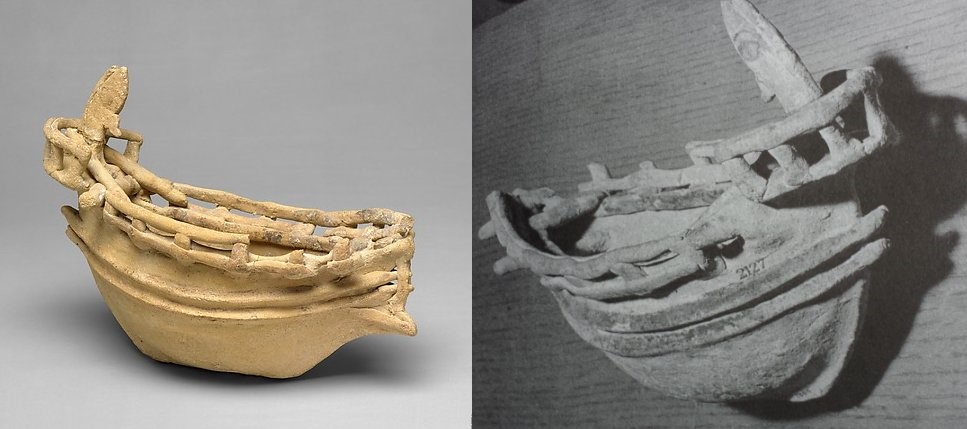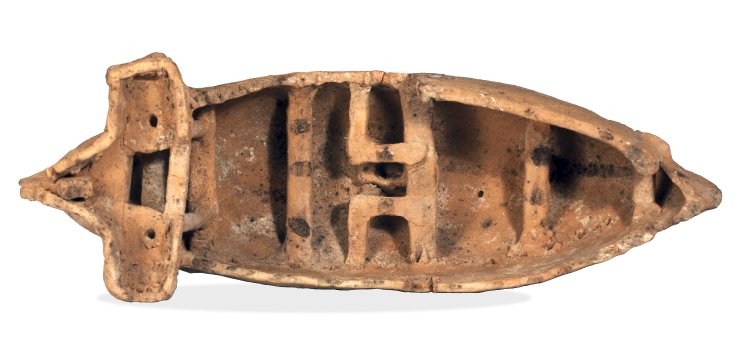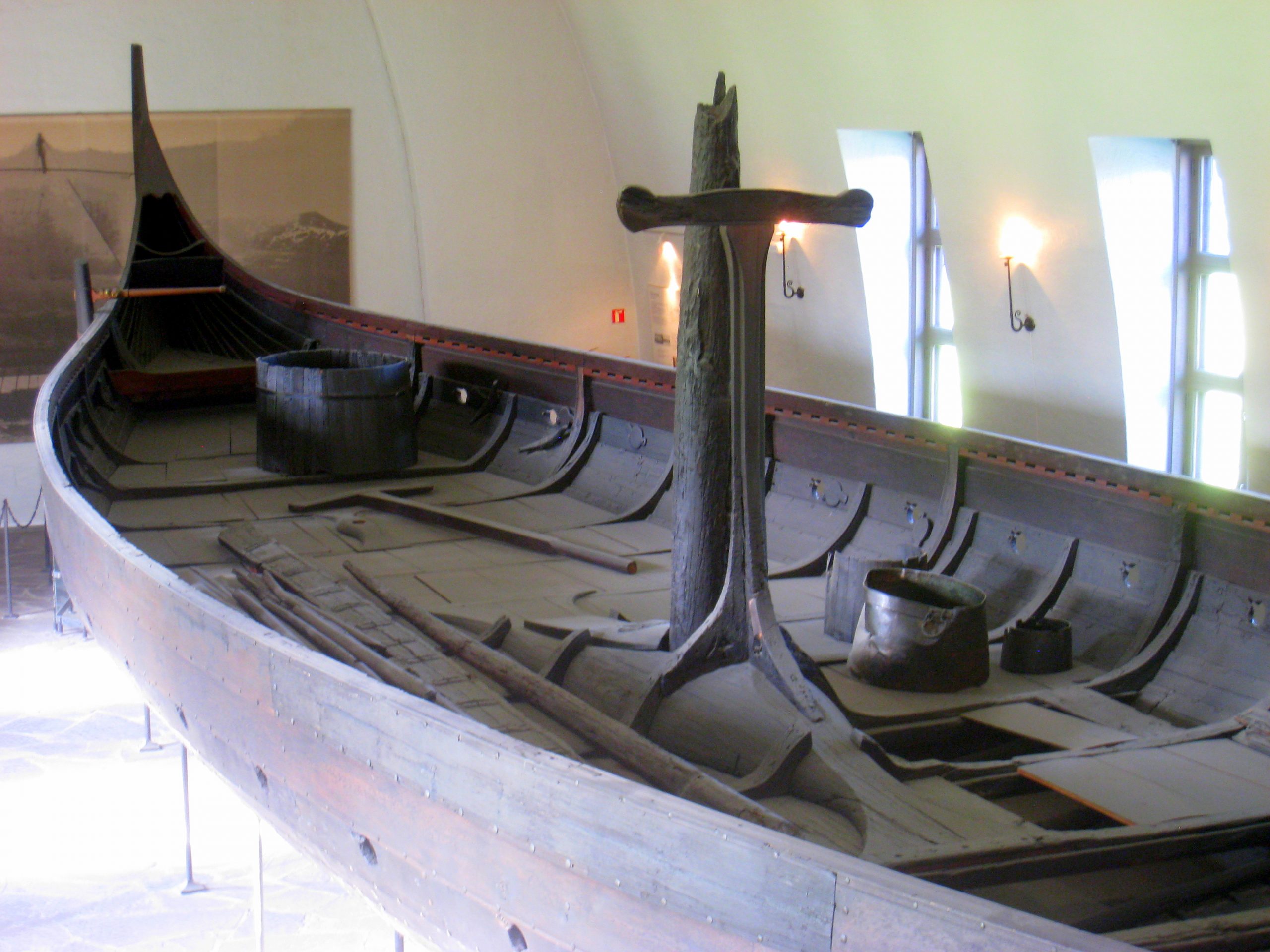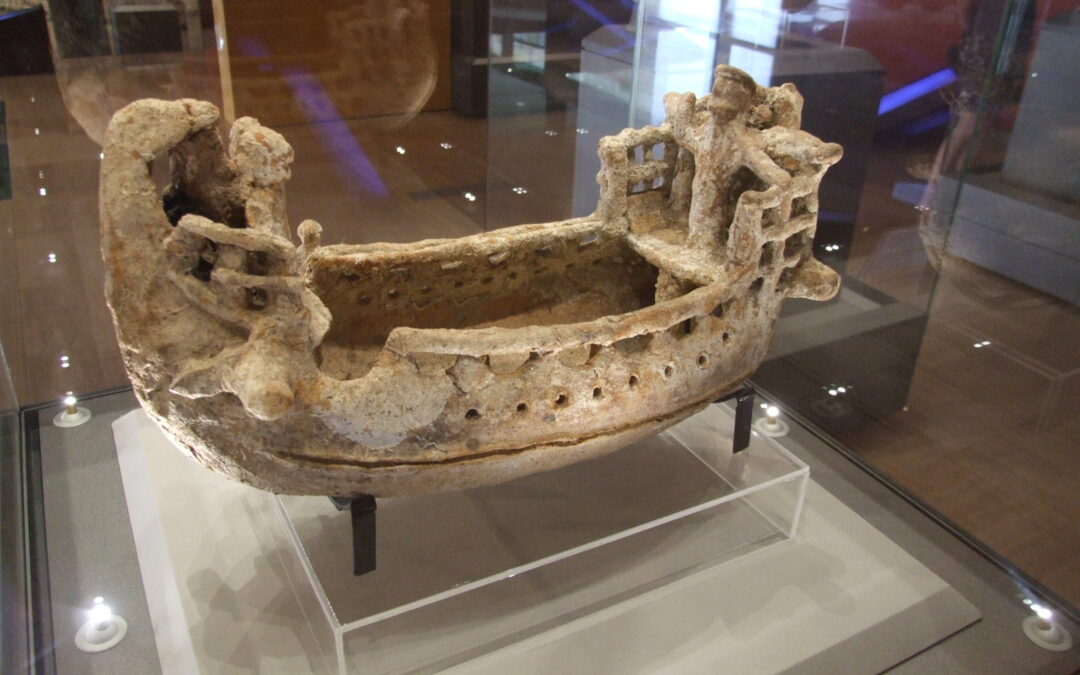The KNVTS has a proud tradition to connect its vision on the future with a view on the historic past of shipbuilding practice. Time for the chair of the KNVTS Ship of the Year Committee to take a step back and reflect on the idea of “vision”. Here is the story of the modelled ship.
This story of modelled ships starts with the description of a clay model found in a tomb [mnēma] at Amathos [1]. It tells us the story of a man who comfortably sits on the aft of his ship without a helm [pēdálion], having a clear vision over the well-built ship – and where it is going to.
Central in this modelled scene of a theōriā is the figure of a spectator who looks both with his eyes and with his mind. He is a state pilgrim [theōros] and we do not know what his role, his activities, will be, both on the journey and at the sanctuary where he is going to.

Single figure who sits back against the railing of the poop-deck. (Terracotta model of a ship. c. 600–480 BCE. The Cesnola Collection, Purchased by subscription, 1874–76. The Metropolitan Museum of Art. New York / Merchantman from Cyprus, 6th BCE, Casson Lionel. 2014. Ships and Seamanship in the Ancient World. Illustration 94.)
This deep and rounded model of a hull shows a transverse beam protruding from the stern quarters of the ship. The extremities of the beam [zygé] are the pivoting points of the rudder-oars [pēdálion]. Furthermore, they accommodate the catheads [epōtides] for the pennants, which are used to control the tillers [oiáklon] of these quarter rudders.
There is a similar transverse beam in the forebody of the ship. In combination with sheaves [ploki] and a cat-fall, it forms the ground-tackle with which the ship’s crew can pull out the anchor [ánkyra] and stow it in a secure position [2].
Histós and epōtides
The forward catheads, with their robust outboard protrusion, would also be the right place for the deck connection of the side-forestays. Protonos and its antonym, epitonos, respectively indicate the forestay and the backstay of a mast. According to Homeric Iliad 1.434, the mast [histós] is let down by slackening the forestays, and then settled into the mast crutch [histodόkē] which consequently must be in the aft of the ship. The aft stays are the standing rigging, tensioned by the running rigging which are the forestays.
The forestays are always described in the plural form [protonoi], indicating that there is “a pair of forestays”. Apollonius of Rhodes describes that there is one on either side of the bow, which would allow them to absorb some side-forces too. The word for catheads, epōtides, is also used for the box-like structures outside of the bulwark, intended for protecting the oars where they pass through the oar ports.
The mast [histós] is let down by slackening the forestays
Thucydides describes the modification of cargo ships to warships by reinforcement of the prow and by adding beams extending from both sides of the prow; ‘the function of these epōtides being to guard the ship against the strokes of the prow of other ships’.
On later Hellenistic ships, the area in between the fore and aft catheads would be filled in by a deck, which area was called the parexeiresia, meaning “outside the oars [eiresia]” [3].
The next ship model, shown at the top, is kept at the Thalassa Agia Napa municipal Museum at Cyprus. It models the type of vessels used around 600-480 BCE, especially in the trade between Amathos – on the southern coast of Cyprus – and Egypt. This model is slightly more detailed than the one represented before and features a raised and ornamented bow shape. The forebody shows the catheads for the ground-tackle and the middle of the ship as far as the prow is undecked [asanidon] [4]. Below the bulwarks, ten oar ports have been pierced in the hull, both on the portside and on starboard.
The aftbody of the model shows again a single figure, standing on the poop-deck, not evidently involved in the operation of the ship. The width of the poop-deck with epōtides exceeds the width of the ship.
Histopédē and mesodme
For a closer look of the internals of the ship, we may look at the terracotta model of another twenty-oared merchant ship [eikosoros] from Amathos, Cyprus, dated about 750-500 BCE. The ship model is kept in the collection of the British Museum. The waterlines of the ship are slender in the forebody and more full in the aftbody which carries a poop-deck.

Terracotta model of a merchant ship from Cyprus (c. 750-500 BCE). (British Museum. © The Trustees of the British Museum. Creative Commons Attribution-NonCommercial-ShareAlike 4.0 International (CC BY-NC-SA 4.0).)
Just visible at the bottom of the ship is the mast step; a construction into which the mast heel is seated [5]. It is from this uncomfortable low viewpoint, the top of the vertical casing, that Odysseus watched and listened to the Sirens [6]. Cross-beams span the deep hull from portside to starboard. The most central beam is fitted with brackets forming a notch which is centred over the mast step [histopédē]. This notch, or mesodme, serves to centre the mast over the mast step and to keep it in its upright position. The mesodme is open towards the aft and closed towards forward, indicating that the mast was lowered in aft direction.
Cross-beams span the deep hull from portside to starboard
This agrees with the event of Homeric Odyssey 12.411 in which the mast does not fall forward, as you would expect on a ship that can run downwind only, but towards aft, upon the head of Baius, the unfortunate helmsman [7]. Casson describes the mesodme as ‘a carling, running fore and aft between two thwarts amidships, that had a hole or notch in it which centred over the mast step’ [8]. It is also translated as “tie-beam” and by others as a “socket in the cross plank” [9].
The picture below shows the mast foot and aft-body of the ninth-century Gokstad Viking ship. The aft part of the mast heel is locked into the mast step by a wedge, which indicates that the mast of this forty-oared Viking Ship was lowered in a similar way as the mast of the ancient Greek ship, namely by lowering it aft, by slackening of the forestay. The Viking ship is wider and less deep than the full-block merchant ship from Cyprus, making the application of the mesodme impractical.

Gokstad Viking ship: mast foot detail (photo by author).
The gift of Kinýras
There is a story of Cypriotic terracotta modelled ships that starts with the introduction of Kinýras, a king of Cyprus. His roots are in Cilicia, Phoenicia, or Syria. At the time of his rule, Cyprus had closer ties to those areas than it did to the Greek speaking world.
Kinýras was renowned for his wealth, which was said to surpass the wealth of Midas and Kroisos. He was a cherished priest of the sea goddess Aphrodite and he started the copper and metallurgical traditions on Cyprus [10]. His name may be connected to that of a musical instrument, a harp named kinnōr, which completes the image of a lyre-playing, temple-building priest-king with Phoenician roots, possibly embodying various historical figures into one mythological person [11]. During the formative stage of Homeric poetry, King Kinýras was already established as the central cult hero of Cyprus.
Like so many of these legendary kings, however, his luck turned sour. A catastrophe kept alive for us by Ovid, tells how Kinýras, now at older age, was unwittingly seduced by his own daughter Myrrha [12]. To escape her father’s anger, she begged the gods to metamorphose her into the myrrh tree. Nine month later, the transformed Myrrha would be feeding her baby Adonis with her sappy tears.
One version of the lost epic Cypria is said to narrate how this king Kinýras donates a fleet of fifty ships to Agamemnon. The ships were to support the transport of the Greek army to the harbour of Troy [13]. Agamemnon’s fleet eventually counted twenty-nine contingents under forty-six captains, accounting for a total of 1186 ships. But none of them from Cyprus.
What went wrong? Did Kinýras break his promise? The great Kinýras, similar in importance to Agamemnon, did not break his promise to contribute ships against Troy. His gift, however, given within the tradition of gift-giving that characterises great kingship, consisted of one full-scale ship and a fleet of forty-nine Cypriotic terracotta modelled ships [14]:
‘Menelaos went with Odysseus and Talthybios to Kinýras in Cyprus and tried to persuade him to join the battle. But he [Kinýras] made a gift of a breastplate for Agamemnon, who was not present; and vowing to send fifty ships, he sent one, which the son of Mygdalion commanded. And moulding the rest out of clay, he launched them into the sea.’ [Apollodorus, Epitome 3.9]
His gift consisted of one full-scale ship and a fleet of forty-nine Cypriotic terracotta modelled ships
Eventually, Kinýras lost his fortune and was – cursed by Agamemnon – driven from power by the Greeks. At the end of his life, Kinýras was buried in the great Cyprian sanctuary [hieron] that he had built for Aphrodite [15].
Picture (top): Terracotta ship model, Cyprus (600-480 BCE). (Treasures of Thalassa Museum, Ayia Napa. Author Claus Ableiter. licensed under the Creative Commons Attribution-Share Alike 3.0 Unported license.)
Series of articles
This is the second in a series of articles. The first, titled “The theoretical ship”, appeared in SWZ|Maritime’s January 2020 issue. Both articles are written by Ing Rien de Meij.

Acknowledgements
Parts of this story have been published at the online community for Classical Studies of The Center for Hellenic Studies, Harvard University, under a Creative Commons Attribution-NonCommercial-NoDerivs 3.0 Unported license (https://kosmossociety.chs.harvard.edu/?p=39734). Where possible, the images have been selected from pictures that are freely available with open source or Creative Commons licenses.
Notes and references
- The Cesnola Collection, Ancient Art from Cyprus, No.2127 The Metropolitan Museum of Art, New York.
- Plokí indicates a block with one or more sheaves. Compare the expression diaplokí; the woven connection between rulers and traders.
- Based on J. S. Morrison, J. F. Coates, N. B. Rankov, The Athenian Trireme: The History and Reconstruction of an Ancient Greek Warship p161. The Greek word parexeiresia suggests some part of the ship concerned with pulling the oars [eiresia] outboard [ex-] and alongside [par-] the hull. Morrison mentions it in the context of the oar system of triērēs.
- Casson, L. 2014. Ships and Seamanship in the Ancient World p151: Undecked: ‘asanidon’. The covered area along either side of the hull is called the ‘deck’ [katástroma] or the ‘platform’ [thranos] or the ‘planking’ [sanidomata]. The latter may derive from é sanís (genitive sanídos), which means a piece of wood. The letter “a” as first part of the word gives the opposite meaning to it; asanidon: without wood.
- Homeric Odyssey 12.51, 62, 179.
- ‘Have them bind you in the swift ship, hands and feet, upright in the step of the mast [histopédē], and have the ends of the ropes be fastened to the mast itself’ [Homeric Odyssey 12.50–51].
- Baius and Misenus, two of the companions of Odysseus [Strabo Geography 1.2.18].
- Casson, L. 2014. Ships and Seamanship in the Ancient World. Princeton University Press.
- Homeric Odyssey 2.424.
- Franklin, J.C. 2016. Kinýras: The Divine Lyre. Hellenic Studies Series 70. Washington, DC: Center for Hellenic Studies.
- Franklin, J.C. 2016. Ibid. Compare Hebrew kinnōr, the lyre famous as the instrument of King David.
- “The royal Kinýras was sprung from her; and if he had been father of no child, might well have been accounted fortunate — but I must sing of horrible events—avoid it daughters! Parents! shun this tale!” Ovid Metamorphoses 10.298–302.
- The ship station of the Achaeans at Troy, the naustathmon, was the beach west of where the river Scamander flowed into the Bay of Troy. Strabo 13.1.31-32 C595, Nagy G. 2010, Homer the Preclassic, p154.
- Apollodorus Epitome 3.9, Eustathios ad Iliad 11.20.
- Foam-sprung Aphrodite (Aphrogenia) had the largest number of epithets related to the sea: Anadyomene (as having risen from the water), Euploia (good sailing), Pontia (of the open sea), Limenia (of the harbor) and Pelagia (of the sea). On the eastern face of the Parthenon frieze, Aphrodite sits right beside Poseidon, Amphitrite (the wife of Poseidon) and the sea goddess Leukotheā.








